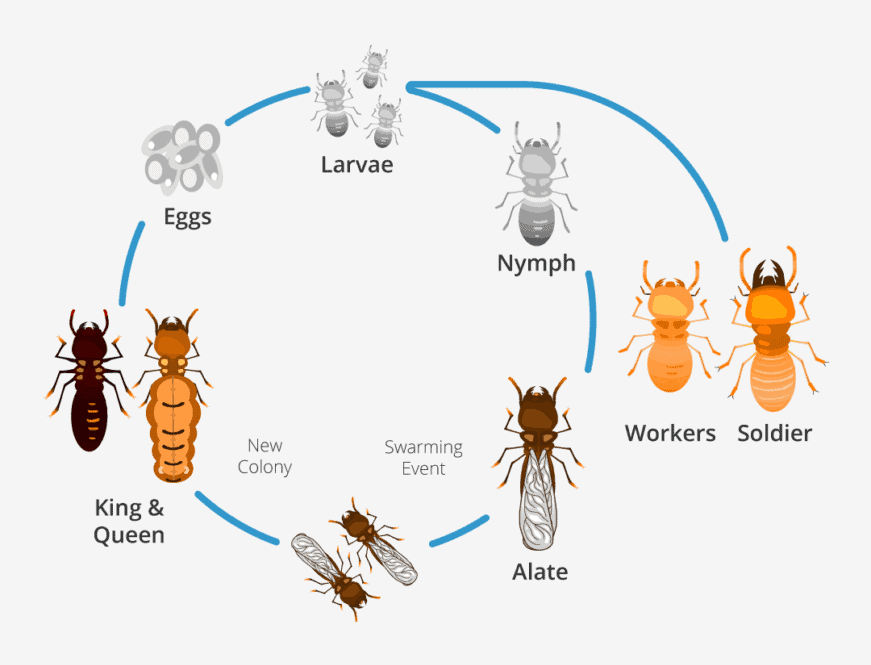
Termites are social insects living in highly organized colonies where each individual has a specific role. Understanding the life cycle of termites is crucial for managing and preventing infestations. In this article, we will explore the termite life cycle from egg to adult, and the different castes (queens, soldiers, workers) and their roles within the colony.
The Life Cycle of Termites
1. Eggs
The life cycle of termites begins with the eggs, which are laid by the queen. The queen can lay thousands of eggs each day, depending on the species. The incubation period for termite eggs is typically between 1 to 2 weeks. During this time, the eggs are carefully tended by the worker termites to ensure they remain in optimal conditions for hatching.
2. Nymphs
Once the eggs hatch, the nymphs emerge. Nymphs are immature termites that go through several molting stages before reaching adulthood. This stage can last from a few weeks to several months, depending on environmental conditions and the species. During this period, nymphs can develop into different castes based on the needs of the colony and the influence of pheromones released by the queen and other termites.
The Termite Castes
3. Workers
Workers make up the majority of the colony and are responsible for various essential tasks:
- Construction and Maintenance: Workers build and maintain tunnels and nests.
- Feeding: They forage for food, primarily wood and other cellulose materials.
- Egg and Nymph Care: Workers tend to the eggs and nymphs, ensuring they are protected and well-fed.
- Feeding Other Members: Through a process called trophallaxis, workers feed other castes, such as soldiers and the queen, by chewing and regurgitating food.
Workers can live for one to two years, continually performing their duties throughout their lifespan.
4. Soldiers
Soldiers protect the colony from predators, such as ants. They have large heads and strong mandibles used for defense. Soldiers cannot feed themselves and rely on workers for nourishment. The lifespan of soldiers is typically around one to two years, similar to that of workers.
5. Reproductive Alates (Alates)
At certain times of the year, reproductive termites, known as alates, emerge from the colony to mate and establish new colonies. This event, known as swarming, usually occurs in the spring and fall. Alates have wings and can be seen flying around light sources. After mating, they shed their wings and search for a suitable location to start a new colony. The entire process, from emergence to colony establishment, can take several weeks.
6. Queen and King
The queen is the primary egg layer of the colony and can live for many years, sometimes over a decade. She can produce thousands of eggs daily, ensuring the colony’s growth and survival. The king, although less prominent, aids in the initial mating and continues to assist in reproduction throughout his life.
7. Secondary and Tertiary Reproductives
In mature colonies, secondary and tertiary reproductives can develop to help expand the colony population. These additional reproductives can take over egg-laying duties if the primary queen dies or if the colony needs to expand into new areas. Their lifespan can vary, but they generally live several years.
The Importance of Understanding the Life Cycle
Knowing the life cycle of termites and the functions of the different castes is essential for developing effective pest control strategies. Understanding how and when termites reproduce and structure their colonies helps in creating targeted methods for prevention and eradication.
Termites are fascinating and highly organized insects whose life and social structure are crucial for their survival. However, their ability to cause significant damage to wooden structures makes them unwanted pests. Prevention and control of termites depend heavily on a deep understanding of their life cycle and behavior. Stay informed and protect your home with regular inspections and effective control methods.
For more information or professional assistance in termite control, feel free to contact Eco Fauna Pest Control. We are here to help you keep your home safe and pest-free!
